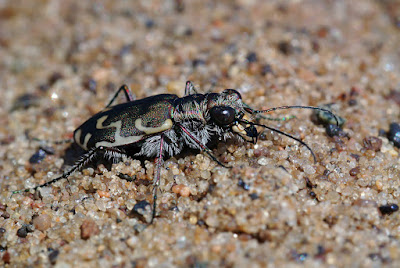― Sara Baume

False Sunflower
August is the beginning of the grand insect apex, which lasts through much of September before cold weather extinguishes their lives. Many birds have already left their breeding grounds in Canada and are well on their way to destinations south. I glanced out my window this morning and saw orange leaves atop one maple in the courtyard. We've lost nearly an hour of daylight since the Summer Solstice and the waning phenological parade makes its last stand. It's astonishing to contemplate all the adaptive strategies at work rendering an apparent silence in order to preserve life through the winter months.

Storms to the North via GEOS-E
Dickcissel songs are seasonally subdued, most silent while some barely represent their kind across the prairies in southern Wisconsin. Many places I've heard them during my commute to work have stopped singing altogether, but there are still a few places where their voices can still be heard. The fields just west of Spring Green Preserve, for example.

Dickcissel
With storms looming to my north, I began Saturday feeling a little uninspired, but eventually decided to meet up with a few friends at the Wisconsin River near Sauk City for tiger beetles. It was the right call ― the weather was perfect for beetling. We found Punctured, Big Sand, Bronzed, and Sandy Stream. However, my favorite insect of the outing was this fascinating Large Chestnut Weevil:

Large Chestnut Weevil
I find them hilariously cartoonish and adorable. What we might take for a gawkish and goofy looking critter is actually a well-adapted entomological marvel. The female weevil drills into a chestnut and deposits an egg or two. When the egg hatches into a larva, the chestnut fruit is consumed. Once the food is gone the larva falls to the ground, buries itself, and pupates for a couple of years. Naturally, this bizarre native insect is considered a nasty pest to chestnut tree farmers trying to earn a living. Incidentally, the fungal Chestnut Blight in the 1900s nearly wiped-out these nifty insects. I'm grateful they weren't, though I doubt my sentiment is shared by chestnut farmers.


And now for some tiger beetle portraits ...

Bronzed Tiger Beetle


Sandy Stream Tiger Beetle
It's tough to pick a favorite tiger beetle, but Sandy Stream is definitely near the top of my list. I think it's on account for how difficult they are to photograph. Although they may look cooperative in portraits, they're extremely wary, fast, and unpredictable fliers. Their elongated elytra and angled maculations are uniquely shaped compared to Bronzed, Hairy-necked, and Big Sand. As a Wisconsin species of special concern, I finally decided to report this location to the DNR's Natural Heritage Inventory. I don't know of any other location along the Wisconsin River where they can be found, though other populations are probable.




The ultimate in arachnid ambush camouflage:

Shoreline Wolf Spider
Versus the stunning coloration of the orb-weaver, Argiope aurantia:

Yellow Garden Spider
Meanwhile the Sedge Wrens sing on and on ...

Sedge Wren
"That is some stamina, some tried and true machine. He cannot get enough of singing, it would seem. You'd think he might wear some parts out, or work some loose with all that steady vibrating and jolting. Or he might stall, totter, stop altogether, and topple, like a battery-powered toy. But he does not. How does he do it? What powers this ultra-tiny-dynamo? Insects and spiders, merely, it is reported, such live things as he can find and tweeze and swallow when not already occupied by singing, or sleeping. Sleeping, yes ― when does he do that?"
― William Burt
All images © 2020 Mike McDowell
